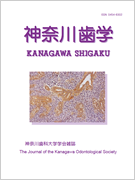- HOME
- > 一般の方
- > バックナンバー:神奈川歯学
- > 30巻2号
- > アブストラクト
アブストラクト(30巻2号:神奈川歯学)

Japanese
| Title : | 上顎咬合平面と顎顔面骨格形態との関連に関する研究 |
|---|---|
| Subtitle : | 原著 |
| Authors : | 酒井博子, 鈴木祥井 |
| Authors(kana) : | |
| Organization : | 神奈川歯科大学歯科矯正学教室 |
| Journal : | 神奈川歯学 |
| Volume : | 30 |
| Number : | 2 |
| Page : | 217-226 |
| Year/Month : | 1995 / 9 |
| Article : | 原著 |
| Publisher : | 神奈川歯科大学学会 |
| Abstract : | 「緒言」 従来, 骨格性不正咬合の成立には, 主に遺伝的要因が関与すると考えられてきた. しかし近年, 環境的要因の影響もきわめて大きいことを示す報告もみられるようになってきている. McNamaraらは, カニクイザルに咬合斜面板を装着し, 下顎を前方に誘導させたところ, 下顎頭の成長が促進をすることを確認した. このことから, 下顎頭の成長には咬合機能が関与していることが示唆された. また, Satoは, 骨格性反対咬合の一部について, 後方臼歯部のデイスクレパンシーにより過剰挺出した上顎臼歯が干渉を起こし, 下顎が引きずりだされるというメカニズムの存在を推測している. さらに, いくつかの臨床例からも, 機能的装置などで咬合機能を変化させると, 下顎の成長や運動に変化が起こることが報告されている. このことは, 顎顔面骨格のうち, とくに下顎骨が, 解剖学的な位置関係から, 上顎骨との咬合機能と密接に関連していることを示唆するものと思われる. |
| Practice : | 歯科学 |
| Keywords : | 上顎咬合平面, 顎顔面骨格形態, 主成分分析, クラスター分析 |
English
| Title : | Study on the Relationship Between the Occlusal Plane and Skeletal Malocclusions |
|---|---|
| Subtitle : | Original article |
| Authors : | Hiroko SAKAI, Yoshii Suzuki |
| Authors(kana) : | |
| Organization : | Department of Orthodontics, Kanagawa Dental College |
| Journal : | Kanagawa Shigaku |
| Volume : | 30 |
| Number : | 2 |
| Page : | 217-226 |
| Year/Month : | 1995 / 9 |
| Article : | Original article |
| Publisher : | Kanagawa Odontological Society |
| Abstract : | Abstract : The purpose of this study to clarify the relationship between the configuration of the occlusal plane and facial skeletal morphology. The materials were cephalometric radiographs from eighty-seven female patients aged 16 to 28 years, with the average being 25 years and 3 months. Six measurements related to the maxillary occlusal plane were analyzed using principal component analysis. Two principal components were proposed in this analysis. The first was the angulation of the maxillary occlusal plane and the second was the vertical dimension of the maxillary first molar. The former related to the mandibular horizontal position, mandibular rotation, and mandibular length, and the latter related to the length of mandibular condyle. From cluster analysis according to the principal components of maxillary occlusal plane configuration, malocclusions were divided into 5 clusters. These clusters were Class II high angle, Class II low angle, Class III high angle, Class III low angle, and Class I medium angle. These results suggested that the angulation of the maxillary occlusal plane and vertical dimension of the maxillary first molar closely related to facial skeletal pattern. So it is useful to change the angulation of the maxillary occlusal plane and vertical dimension of the maxillary first molar for the control of facial skeletal pattern. |
| Practice : | Dentistry |
| Keywords : |
